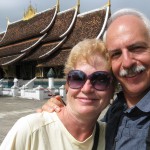
Our two days enjoying Luang Prabang showed us the substantial charms of the place. It’s like a city in a garden, with narrow lanes leading past the guesthouses, ageing and restored French colonial buildings of white stucco and modest decoration, plus more indigenous teak structures on stilts (with first floor rooms added as an afterthought), all in a very soothing blend of French charm and Asian culture. The balance has been insured by the declaration of this as a World Heritage site too so the extensive restorations are done with strict controls.

The riverways are lined with tiny restaurants that prove so pleasant for a drink or meal, and tropical plants are everywhere as well. Even small guesthouses were delightfully inviting. The commercial bustle is subdued and much quieter than Thai cities, but the now familiar night markets and particularly food markets are all there too.
Visitors are numerous, though apparently not in the usual quantity. Their demographic veers more to the extremes, either young (or not so young) backpackers roughing it, or older, richer colonialists enjoying the treats.
Why anyone would want to ride instead of walk about town is beyond us, but our guide commented that it had been three months since he had done a walking tour, as most people think it either too difficult or too hot to walk. Temperatures here in the hills are never so bad now, and the usual morning fog can be downright chilly.
Of course, we saw four temples today. With one exception, most of these have been destroyed and rebuilt, but you can still learn much about the pride and religion that created them.

And you can learn about the differences between Thai and Lao architecture – and culture. Thais are more elaborate in their temple buildings and even their Buddhas more decorated as well. By contrast, Lao temples are plain, they use multiple curved roofs likened to a mother hen spreading it’s wings in protection (the oldest one featuring five layers of roof), have columnar wooden pillars set in the windows, a striking golden ornaments in the center of the roof. But, the Lao are quite flexible, allowing wealthy Thais to place decorative robes and other dressing on the Buddhas. They also allow them to build their own ornate temples in the same complexes.

We detected some friction despite the tolerance, not surprising considering these bits of cultural imperialism and that the Thais were one of those peoples that invaded and crushed Laos over the last few centuries. One temple even included two enormous Buddha statues, one behind the other, with the rear one in simpler Lao style and the front one in more elaborate Thai style. The Thais didn’t dare replace the former one, but just subordinated it to their preferred version.
Sadly, even the groups of Thai tourists today acted boorishly and disrespectfully. They photographed themselves with the Buddha which is disallowed anywhere. They walked in areas that were off limits. They talked loudly. In our guide’s opinion, Thais think they are better than the Laotians, having so recently been their masters. But perhaps all tourists in groups forget to behave well.
And then there’s the French influence from their 60 year rule over Laos till 1954. It was obvious in the colonial buildings and the European charm of the streets. It was sadly obvious in the Grand Palace of the kings that they sanctioned. Undamaged by subsequent communist regimes, the building was originally a blocky, early 20th century French stucco structure, but made more Lao in style by later kings. Now a museum, it recalls the lifestyle and regalia of those kings, who did in fact live in fairly plain Lao style not unlike the later Hapsburgs in Vienna. A display of gifts to the kings a cheesy mockup of the moon lander from the U.S. along with a miniature Lao flag that went to the moon, apparently in appreciation for the Lao government letting us do what we wanted to in their country during the Vietnam war.
And the French left their mark on the desserts of Laos. There are many, many pastry shops and night stalls offering cakes, baguettes, sweet rolls and other such goodies. Even the morning breakfast comes with a form two small baguettes. Ooh, la, la!
(For more pictures from Laos, click HERE to see the slide show at the end of the Laos itinerary.)

